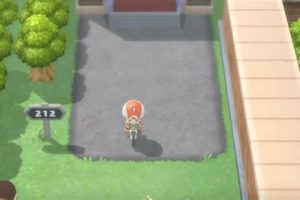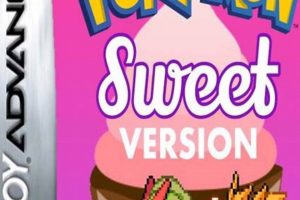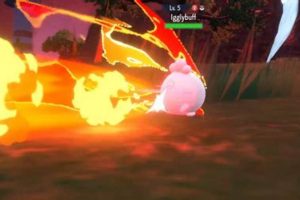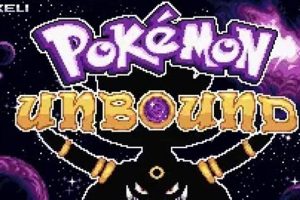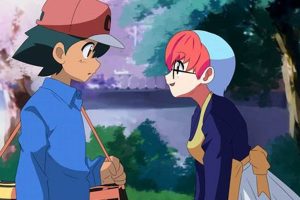This collectible card series, released in 2000, centered on the Gym Leader characters from the popular animated series and video games. Each card in the series featured artwork and gameplay elements relating to these prominent figures, such as Brock, Misty, and Lt. Surge, and their signature Pokmon. For example, a card might depict Brock’s Onix with a special ability reflecting its Rock-type strength.
The introduction of these well-known personalities added a narrative depth to the trading card game, enhancing the collecting experience for fans. It offered a different approach from focusing solely on the standard Pokmon roster, and provided a unique avenue for players to build decks around specific strategies and thematic teams. This collection holds historical significance within the broader Pokmon Trading Card Game landscape, representing a key stage in the evolution of set design and game mechanics.
The following sections will delve into specific aspects of the series, including notable cards, rarity considerations, and its impact on the secondary market for collectors and enthusiasts. Details on identifying authentic cards and understanding their potential value will also be provided.
Successful acquisition and assessment of cards from the specified series require meticulous attention to detail and a comprehensive understanding of the set’s characteristics.
Tip 1: Examine Card Condition Diligently: The physical state of each card significantly impacts its value. Scrutinize cards for creases, edge wear, surface scratches, and centering issues. Mint condition cards command a substantial premium.
Tip 2: Verify Card Authenticity: Counterfeit cards exist within the marketplace. Compare the print quality, color saturation, and font usage against known authentic examples. Utilize resources such as online databases and collector forums to aid in verification.
Tip 3: Understand Rarity Designations: The series utilizes common, uncommon, and rare designations. Rare Holo cards, in particular, represent a potentially significant investment opportunity. Familiarize yourself with the symbol system used to denote rarity.
Tip 4: Research Market Values: Track sales data from reputable online marketplaces and auction sites to gauge current market prices for specific cards. Price fluctuations are influenced by factors such as demand, condition, and scarcity.
Tip 5: Scrutinize Holofoil Patterns: The holofoil pattern on Holo cards should be examined closely. Authentic cards exhibit specific and consistent patterns. Deviation from these patterns may indicate a counterfeit card.
Tip 6: Investigate Printing Anomalies: Some cards may exhibit printing errors or variations. These anomalies can, in certain cases, increase the card’s value, particularly if the error is rare or visually distinct. Thoroughly research any apparent anomalies before making a purchasing decision.
Consistent application of these guidelines will facilitate a more informed and potentially profitable experience with the collection. Careful assessment reduces the risk of acquiring misrepresented or counterfeit items.
The subsequent section will address the legacy of this collection and its continued relevance within the broader Pokmon Trading Card Game community.
1. Gym Leader Focus
The “pokemon gym heroes set” derives its core identity from a central thematic element: an emphasis on Gym Leaders, the prominent characters that players challenge in the video games and encounter in the animated series. This focus permeates every aspect of the set, shaping card selection, artwork, and strategic gameplay implications.
- Character Representation
Gym Leaders are featured directly on Trainer cards, each providing unique abilities or effects. For example, “Brock” might allow the player to search their deck for a Rock-type Pokmon. This direct representation of established characters allows for a deeper narrative connection for players familiar with the source material.
- Thematic Deck Construction
The set encourages players to build decks centered around specific Gym Leaders, as many Pokmon cards bear the name of a particular leader (e.g., “Misty’s Seadra”). This necessitates strategic decisions regarding type matchups and synergy within a thematic framework, fostering a different style of deck-building compared to simply assembling the most powerful cards available.
- Distinct Visual Identity
The artwork frequently depicts the Gym Leader alongside their signature Pokmon, reinforcing the connection between the character and their team. This visual branding contributes to the set’s overall aesthetic and appeal, distinguishing it from sets that focus solely on the Pokmon themselves.
- Narrative Immersion
The collection integrates elements of the source material’s storyline, as cards and abilities reflect the Gym Leader’s personality and battle style. This immersion into the narrative enhances the collecting and playing experience, providing a layer of depth beyond the mechanics of the trading card game.
By prioritizing characters from the Pokmon universe, the previously mentioned series offered a narrative-driven experience. The focus on Gym Leaders, incorporated into both gameplay and design, resulted in the release of a uniquely themed set.
2. Dual-Type Cards
The introduction of dual-type Pokmon cards significantly influenced the strategic depth and deck-building possibilities within the “pokemon gym heroes set.” These cards, possessing two elemental types, deviated from the traditional single-type paradigm, impacting both offensive and defensive considerations.
- Strategic Type Coverage
Dual-type cards inherently offer broader type coverage compared to their single-type counterparts. A card such as Erika’s Venusaur (Grass/Poison) can exploit weaknesses of both Water and Psychic Pokmon, providing increased versatility in battle. This adaptability forces opponents to consider a wider range of potential vulnerabilities when deploying their own Pokmon.
- Complex Weakness/Resistance Interactions
The interaction between weaknesses and resistances becomes more nuanced with dual-type Pokmon. While one type might grant resistance to a specific element, the other could simultaneously introduce a new weakness. This complexity demands careful evaluation of type matchups and strategic deployment to maximize advantages and minimize vulnerabilities.
- Enhanced Deck-Building Flexibility
The presence of dual-type Pokmon enables more flexible deck-building strategies. Players can incorporate these cards to cover multiple type weaknesses within a single deck, reducing the need for dedicated single-type counters. This allows for greater overall deck cohesion and resource efficiency.
- Impact on Energy Card Requirements
Dual-type cards can influence energy card allocation within a deck. Some cards may require energy of both their types to execute attacks, necessitating a balanced energy distribution. This can present a challenge in maintaining consistent energy flow, requiring careful consideration of energy acceleration tactics and resource management.
The inclusion of dual-type Pokmon cards in the mentioned series introduced a layer of complexity that elevated both the strategic depth and deck-building options. Their presence necessitates careful evaluation of type matchups, energy requirements, and overall deck composition, thereby enriching the gameplay experience.
3. Holofoil Rarity
The prevalence of holofoil cards significantly influences the collector’s perception and economic value of the “pokemon gym heroes set”. Cards featuring a holographic treatment, applied to the artwork section, are designated as ‘Rare Holo’ and constitute a subset of the overall ‘Rare’ designation. This scarcity directly correlates with increased demand, positioning these cards as prime targets for collectors and investors seeking to acquire valuable additions to their collections. The holographic layer is not merely aesthetic; its presence differentiates cards and serves as a visual indicator of relative rarity within the set.
For example, a non-holographic version of a rare card, such as Erika’s Venusaur, possesses considerably less monetary worth compared to its holofoil counterpart. This disparity is not solely attributable to aesthetics; it stems from the fact that the holofoil version was produced in lower quantities, thereby rendering it more difficult to obtain. The condition of the holofoil layer further affects value; scratches, creases, or blemishes diminish desirability and subsequent market price. Authentic holofoil cards exhibit a consistent and specific pattern. Irregularities in this pattern are indicative of potential counterfeiting.
The holofoil cards from this particular set represent a significant portion of the set’s overall market value. Understanding the grading criteria and authentication methods for these cards is crucial for collectors aiming to make informed purchasing or selling decisions. Ultimately, the combination of visual appeal and limited availability makes these cards a cornerstone of the collection, driving interest and contributing to the enduring appeal of the collection among enthusiasts and investors alike.
4. Set Symbol
The “Set Symbol” represents a crucial element for identifying cards originating from the “pokemon gym heroes set”. This symbol, unique to the collection, is consistently present on each card and serves as a primary means of authentication. The symbol, depicting two crossed swords overlaid on a stylized shield, distinguishes this series from all other Pokmon Trading Card Game expansions. Its presence allows collectors to immediately verify the card’s origin and contextualize it within the broader card game ecosystem. Without the symbol, determining a card’s set of origin becomes significantly more difficult, potentially leading to misidentification or vulnerability to counterfeiting. Thus, the symbol’s existence is not arbitrary; it is a fundamental component of the cards themselves.
A practical example highlighting the importance of the symbol involves identifying a “Brock’s Ninetales” card. While the artwork may be similar to other Ninetales cards from different sets, the presence of the specific shield and sword symbol confirms its origin within the “pokemon gym heroes set”. This information directly influences its collectability and market value. Collectors routinely utilize set symbols to categorize and organize their collections, ensuring accurate inventory management and facilitating informed trading decisions. Similarly, retailers and auction houses rely on these symbols to properly label and price individual cards, ensuring fair market transactions. Erroneous identification, resulting from the absence or misinterpretation of the symbol, can lead to financial discrepancies and undermine the integrity of the collecting community.
In summation, the set symbol is indispensable for establishing the provenance of cards within this specific collection. Its reliable presence acts as a safeguard against misidentification and fraud, while also assisting collectors in the organization of their inventories. Understanding the purpose and recognition of the set symbol is, therefore, paramount for anyone engaging with the “pokemon gym heroes set,” whether as a collector, seller, or enthusiast. The accurate interpretation of this symbol facilitates informed decisions and contributes to the maintenance of market transparency within the Pokmon Trading Card Game community.
5. Energy Acceleration
Energy acceleration, a critical strategic element within the Pokmon Trading Card Game, is prominently featured in the “pokemon gym heroes set.” The mechanics of the game require energy cards to be attached to Pokmon in order to activate attacks and abilities. The rate at which these energy cards can be deployed directly influences a player’s ability to execute their strategy effectively. Therefore, cards that circumvent the standard one-energy-per-turn rule, offering faster energy attachment, are highly valued. Several Trainer cards and Pokmon abilities within the series provide these acceleration capabilities. This design choice has a direct impact on deck construction and gameplay tactics within the set.
An example of effective energy acceleration can be seen through the use of “Brock’s Training Method.” This Trainer card allows a player to search their deck for a basic Fighting Energy card and attach it to one of their Fighting Pokmon. This represents a significant advantage, particularly in the early game, allowing for quicker access to powerful attacks. Similarly, some Pokmon have abilities that facilitate energy attachment from the discard pile or other zones. The inclusion of these cards promotes aggressive gameplay and faster deck cycling, thereby shortening the time required to set up powerful attackers. Players must carefully balance the inclusion of these acceleration tools with the other components of their deck to ensure consistency and maintain strategic flexibility.
The incorporation of energy acceleration cards significantly shapes the metagame for the series. Decks that can reliably deploy energy quickly gain a considerable advantage, forcing opponents to respond with disruption tactics or their own acceleration strategies. This dynamic interaction creates a strategic arms race, incentivizing players to continuously optimize their deck construction and adapt to the prevailing meta. The presence of powerful energy acceleration cards thus distinguishes the series and contributes to its overall strategic depth. Recognizing and understanding the value of energy acceleration within the series are paramount for competitive play and effective deck building.
6. Trainer Card Variety
The “pokemon gym heroes set” distinguishes itself, in part, through its diverse selection of Trainer cards. This variety directly impacts gameplay by providing players with a multitude of strategic options beyond simply attacking with Pokmon. The inclusion of numerous Trainer cards, each with a specific function, leads to more intricate deck-building decisions and dynamic match scenarios. The strategic depth introduced by this card type is integral to the overall experience of the set. This contrasts with sets that prioritize raw Pokmon power, instead emphasizing tactical maneuvers and resource management. For instance, cards that manipulate the discard pile, search the deck for specific cards, or disrupt the opponent’s strategy each contribute to the nuanced gameplay characteristic of this series.
Specifically, Trainer cards within the series encompass a range of effects, including: Item cards that provide immediate benefits, Supporter cards that offer powerful, turn-based effects, and Stadium cards that alter the game’s environment. “Brock’s Protection” acts as an Item card, preventing damage to a Fighting-type Pokmon. “Misty’s Wrath” is a Supporter card that inflicts damage based on the opponent’s hand size. Celadon City Gym serves as a Stadium card which changes basic game parameters. These examples highlight the diverse roles that Trainer cards fulfill and their impact on the overall strategic landscape. Decks that effectively utilize Trainer cards gain a significant advantage, as they are better equipped to control the flow of the game and adapt to unexpected situations. The absence of such cards limits player agency and reduces the potential for strategic maneuvering.
In summary, the extensive array of Trainer cards within the “pokemon gym heroes set” fundamentally shapes the gameplay experience. This variety fosters strategic deck construction, promotes dynamic matches, and increases the overall complexity of the game. Understanding the function and application of these cards is essential for achieving success and fully appreciating the strategic nuances of the set. The strategic importance and relative abundance of Trainer cards within this series distinguishes it from other expansions and contributes to its enduring appeal among dedicated players and collectors.
7. Artwork Style
The visual aesthetic of the “pokemon gym heroes set” is a defining characteristic that reflects both the era in which it was released and the source material it adapts. The artwork style influences the overall appeal and contributes significantly to the collector’s perception of the cards.
- Character Design Consistency
The artwork maintains consistent character designs aligned with the animated series. Gym Leaders and their signature Pokmon retain familiar visual traits, reinforcing their established identities. This consistency allows fans to immediately recognize and connect with the portrayed characters, enhancing the set’s appeal.
- Background Detail and Composition
The level of background detail varies across the cards. Some feature simple, minimalist backgrounds that place emphasis on the Pokmon or character, while others incorporate more elaborate scenery reminiscent of the Gym environments from the video games. The composition of each card, including character placement and pose, impacts the overall visual impact and storytelling aspect of the artwork.
- Color Palette and Rendering Techniques
The color palette typically employs bright, saturated hues that align with the vibrant aesthetic of the Pokmon franchise. Rendering techniques, such as shading and highlighting, contribute to the visual depth and dimensionality of the artwork. These techniques create visual interest and enhance the overall aesthetic appeal.
- Typographic Integration
The integration of text, including Pokmon names, attack descriptions, and flavor text, is carefully considered in relation to the artwork. The font style, size, and placement contribute to the card’s overall readability and visual harmony. Effective typographic integration ensures that the text complements the artwork without detracting from its impact.
In conclusion, the artwork style of the previously mentioned series is a crucial component that contributes to its unique identity and appeal. Consistent character designs, varying levels of background detail, vibrant color palettes, and thoughtful typographic integration collectively shape the visual experience and influence the collector’s perception of the cards. Understanding these aspects allows for a deeper appreciation of the set’s aesthetic qualities and its place within the larger Pokmon Trading Card Game landscape.
Frequently Asked Questions
This section addresses common inquiries and clarifies prevalent misconceptions regarding the specifics of the aforementioned collection.
Question 1: What distinguishes the “pokemon gym heroes set” from other Pokmon Trading Card Game expansions?
The distinguishing feature lies in its thematic focus on Gym Leader characters from the Pokmon universe. These leaders are prominently featured on Trainer cards and influence the selection of Pokmon included within the set.
Question 2: How can one identify authentic cards from the mentioned collection?
Authenticity can be verified by examining the set symbol (crossed swords on a shield), print quality, and holofoil patterns on rare cards. Comparison with known authentic examples is recommended.
Question 3: Are all rare cards in the series holofoil?
No, not all rare cards are holofoil. The “Rare Holo” designation indicates a specific subset of rare cards featuring the holographic treatment. Non-holographic rare cards exist within the set.
Question 4: What factors influence the market value of cards from this set?
Market value is primarily determined by card condition, rarity, and demand. Holofoil cards in mint condition command the highest prices.
Question 5: Did the “pokemon gym heroes set” introduce any new game mechanics?
While the set did not introduce entirely novel mechanics, it emphasized energy acceleration strategies through Trainer cards and Pokmon abilities, influencing deck construction and gameplay tactics.
Question 6: Where can one acquire cards from the specified collection?
Cards can be acquired from online marketplaces, auction sites, and specialized trading card retailers. Due diligence is crucial to ensure authenticity and fair pricing.
In summary, understanding the thematic focus, authentication methods, and market dynamics of the “pokemon gym heroes set” is essential for collectors and players. This information facilitates informed decisions and protects against potential fraud.
The following resources offer additional details on specific cards and gameplay strategies within the set.
pokemon gym heroes set
This exploration of the “pokemon gym heroes set” has illuminated its defining characteristics, from the Gym Leader-centric theme to the impact of holofoil rarity and energy acceleration strategies. The set’s design choices, including the variety of Trainer cards and consistent artwork style, collectively contribute to its unique identity within the Pokmon Trading Card Game ecosystem.
The historical and strategic significance of this particular set remains relevant for collectors and players alike. Continued appreciation for its nuances ensures its enduring legacy within the broader trading card game community, prompting ongoing analysis and informed engagement with its distinctive elements.


